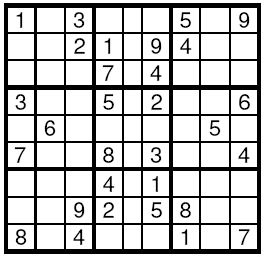|
Sudoku
Description
Sudoku is a very simple task. A square table with 9 rows and 9 columns is divided to 9 smaller squares 3x3 as shown on the Figure. In some of the cells are written decimal digits from 1 to 9. The other cells are empty. The goal is to fill the empty cells with
decimal digits from 1 to 9, one digit per cell, in such way that in each row, in each column and in each marked 3x3 subsquare, all the digits from 1 to 9 to appear. Write a program to solve a given Sudoku-task.  Input
The input data will start with the number of the test cases. For each test case, 9 lines follow, corresponding to the rows of the table. On each line a string of exactly 9 decimal digits is given, corresponding to the cells in this line. If a cell is empty
it is represented by 0. Output
For each test case your program should print the solution in the same format as the input data. The empty cells have to be filled according to the rules. If solutions is not unique, then the program may print any one of them.
Sample Input 1 103000509 002109400 000704000 300502006 060000050 700803004 000401000 009205800 804000107 Sample Output 143628579 572139468 986754231 391542786 468917352 725863914 237481695 619275843 854396127 Source |
||||||||||
题意:
填数独。
思路:
标记。暴力dfs。
#include<algorithm>
#include<iostream>
#include<string.h>
#include<sstream>
#include<stdio.h>
#include<math.h>
#include<vector>
#include<string>
#include<queue>
#include<set>
#include<map>
//#pragma comment(linker,"/STACK:1024000000,1024000000")
using namespace std;
const int INF=0x3f3f3f3f;
const double eps=1e-8;
const double PI=acos(-1.0);
const int maxn=100010;
typedef __int64 ll;
bool row[15][15],col[15][15],blk[5][5][15];//标记行列块的九个数字是否被使用
char maze[15][15];//存数独
int cnt;//记录未填格子数
struct yb
{
int x,y;
} blank[100];//未填格子的坐标
void init()
{
cnt=0;
memset(row,0,sizeof row);
memset(col,0,sizeof col);
memset(blk,0,sizeof blk);
}
bool dfs()
{
int x,y,i;
if(cnt==0)
return true;
x=blank[cnt-1].x;
y=blank[cnt-1].y;
for(i=1;i<=9;i++)//枚举当前未填格的数字
{
if(!row[x][i]&&!col[y][i]&&!blk[(x+2)/3][(y+2)/3][i])//行列块都未被使用
{
row[x][i]=col[y][i]=blk[(x+2)/3][(y+2)/3][i]=true;
maze[x][y]='0'+i;
cnt--;
if(dfs())
return true;
row[x][i]=col[y][i]=blk[(x+2)/3][(y+2)/3][i]=false;//回溯
cnt++;
}
}
return false;
}
int main()
{
int cas,i,j,t;
scanf("%d",&cas);
while(cas--)
{
for(i=1;i<=9;i++)
scanf("%s",maze[i]+1);
init();
for(i=1;i<=9;i++)
{
for(j=1;j<=9;j++)
{
t=maze[i][j]-'0';
row[i][t]=col[j][t]=blk[(i+2)/3][(j+2)/3][t]=true;
if(maze[i][j]=='0')//记录未填格的位置
{
blank[cnt].x=i;
blank[cnt++].y=j;
}
}
}
if(dfs())
for(i=1;i<=9;i++)
printf("%s\n",maze[i]+1);
}
return 0;
}